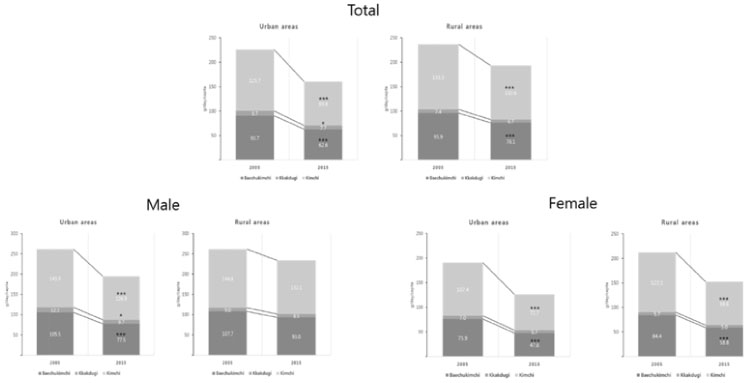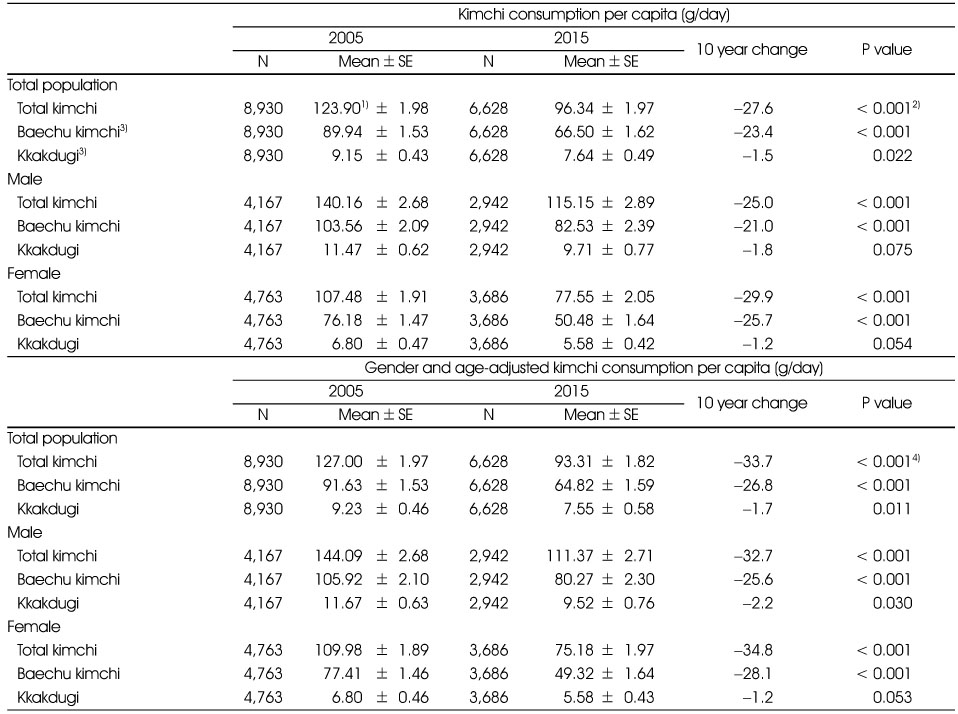References
1. Jang DJ, Chung KR, Yang HJ, Kim KS, Kwon DY. Discussion on the origin of kimchi, representative of Korean unique fermented vegetables. J Ethn Food 2015;2(3):126–136.
2. Korea Health Industry Development Institute (KHIDI). National Food & Nutrition Statistics 2013: based on 2013 Korea National Health and Nutrition Examination Survey Korea Health Industry Development Institute (KHIDI); 2015. cited 2017 Feb 16. Available from:
https://www.khidi.or.kr/.
3. Choi J, Moon HK. Comparison of dietary patterns by sex and urbanization in different economic status. Korean J Community Nutr 2008;13(3):346–358.
4. Song Y, Joung H. A traditional Korean dietary pattern and metabolic syndrome abnormalities. Nutr Metab Cardiovasc Dis 2012;22(5):456–462.
5. Kim EK, Park YK, Ju SY, Choi EO. A study on the kimchi consumption of Korean adults: Using Korea National Health and Nutrition Examination Survey (2010~2012). Korean J Food Cult 2015;30(4):406–412.
6. Kang M, Joung H, Lim JH, Lee YS, Song YJ. Secular trend in dietary patterns in a Korean adult population, using the 1998, 2001, and 2005 Korean National Health and Nutrition Examination Survey. Korean J Nutr 2011;44(2):152–161.
7. Park YH, Kang M, Baik HW, Oh SW, Park SJ, Paik HY. A study on the perception as HANSIK (Korean food) for the common dishes in Korean adults residing in Seoul and metropolitan area. Korean J Community Nutr 2012;17(5):555–578.
8. Kim JH, Yoon HR. A survey on the nationwide customers' usage of kimchi consumption. Korean J Food Nutr 2012;25(2):299–307.
9. Kim DY, Lee H, Choue R. Comparative study on awareness, preference and sensory evaluation of kimchi in Chinese and Korean students residing in Korea. Korean J Food Cult 2013;28(2):158–166.
10. Ryu JC, Park KY. Anticlastogenic effect of baechu (Chinese cabbage) kimchi and buchu (leek) kimchi in mitomycin C-induced micronucleus formations by supravital staining of mouse peripheral reticulocytes. Environ Mutagen Carcinog 2001;21(1):51–56.
11. Hur YM, Kim SH, Park KY. Inhibitory effects of kimchi extracts on the growth and DNA synthesis of human cancer cells. J Food Sci Nutr 1999;4(2):107–112.
12. Kim BK, Choi JM, Kang SA, Park KY, Cho EJ. Antioxidative effects of kimchi under different fermentation stage on radical-induced oxidative stress. Nutr Res Pract 2014;8(6):638–643.
13. Kim JH, Ryu JD, Song YO. The effect of kimchi intake on free radical production and the inhibition of oxidation in young adults and the elderly people. Korean J Community Nutr 2002;7(2):257–265.
14. Sousa R, Halper J, Zhang J, Lewis SJ, Li WIO. Effect of lactobacillus acidophilus supernatants on body weight and leptin expression in rats. BMC Complement Altern Med 2008;8(1):5.
15. Kwon JY, Cheigh HS, Song YO. Weight reduction and lipid lowering effects of kimchi lactic acid powder in rats fed high fat diets. Korean J Food Sci Technol 2004;36(6):1014–1019.
16. Cheigh HS. Critical review on biochemical characteristics of kimchi (Korean fermented vegetable products). J East Asian Soc Diet Life 1995;5(2):89–101.
17. Kim HR, Kim MS, Kim MH, Son CW, Kwak ES, Heo OS. Analysis of sodium(Na) and potassium(K) content of side dishes purchased from traditional and super market in Daejeon area. J East Asian Soc Dietary Life 2009;19(3):350–355.
18. Song MR, Lee KJ. Salinity and consumption patterns of kimchi and soup stew in Jeonju area. Korean J Food Cookery Sci 2008;24(1):84–91.
19. Song DY, Park JE, Shim JE, Lee JE. Trends in the major dish groups and food groups contributing to sodium intake in the Korea National Health and Nutrition Examination Survey 1998-2010. Korean J Nutr 2013;46(1):72–85.
20. Karppanen H, Mervaala E. Sodium intake and hypertension. Prog Cardiovasc Dis 2006;49(2):59–75.
22. Park H, Lee M, Yoon E, Chung H. Sodium reduction in traditional fermented foods. Food Sci Ind 2016;49(2):34–44.
23. Song HJ, Lee HJ. Consumption of kimchi, a salt fermented vegetable, is not associated with hypertension prevalence. J Ethn Food 2014;1(1):8–12.
24. Song HJ, Park SJ, Jang DJ, Kwon DY, Lee HJ. High consumption of salt-fermented vegetables and hypertension risk in adults: a 12-year follow-up study. Asia Pac J Clin Nutr 2016;10.6133/apjcn.042016.13.
25. Zhao X, Yin X, Li X, Yan LL, Lam CT, Li S. Using a low-sodium, high-potassium salt substitute to reduce blood pressure among Tibetans with high blood pressure: A patient-blinded randomized controlled trial. PLoS One 2014;9(10):e110131.
26. Rodrigues SL, Baldo MP, Machado RC, Forechi L, Molina MDCB, Mill JG. High potassium intake blunts the effect of elevated sodium intake on blood pressure levels. J Am Soc Hypertens 2014;8(4):232–238.
27. Kim IW, Cho YB. A study on preference for purchase and ingestion of kimchi among Busan residents. Culi Sci Hos Res 2006;12(4):187–198.
28. Kim JH, Park WP, Kim JS, Park JH, Ryu JD, Lee HG. A survey on the actual state in kimchi in Kyung-nam(II): The study of the notion and preference of kimchi products for sale. Korean J Diet Cult 2000;15(2):147–153.
29. Lee GY, Park ES, Park KY. Survey on kimchi intake patterns and attitudes towards development of functional kimchi among middle and high school students in Busan area. J Korean Soc Food Sci Nutr 2015;44(8):1226–1233.
30. Korea Health Industry Development Institute (KHIDI). The Third National Health & Nutrition Examination Survey, 2005: Nutrition Survey Korea Health Industry Development Institute (KHIDI); 2006. cited 2017 Feb 16. Available from:
https://www.khidi.or.kr/.
31. Kang JH, Lee KA. The perception, preferences, and intake of Korean traditional foods of elementary school students: Focusing on kimchi, tteok and eumcheong varieties. Korean J Food Cult 2008;23(5):543–555.
32. Ha AW, Ju SY. Nutrient intakes and frequently consumed foods among Korean adults according to the intake frequency of Baechu (Chinese cabbage) kimchi: Based on the 2012~2013 Korea National Health and Nutrition Examination Survey. J Nutr Health 2016;49(2):125–133.
33. World Institute of Kimchi. Mission and Function [Internet] World Institute of Kimchi; 2017. cited 2017 Feb 14. Available from:
https://www.wikim.re.kr/.
35. Kim HR, Kim MS, Kim MH, Son CW, Kwak ES, Heo OS. Analysis of sodium(Na) and potassium(K) content of side dishes purchased from traditional and super market in Daejeon area. J East Asian Soc Dietary Life 2009;19(3):350–355.
36. Song MR, Lee KJ. Salinity and consumption patterns of kimchi and soup stew in Jeonju area. Korean J Food Cookery Sci 2008;24(1):84–91.
37. Moon HK, Choi SO, Kim JE. Dishes contributing to sodium intake of elderly living in rural areas. Korean J Community Nutr 2009;14(1):123–136.
38. Song YJ, Paik HY, Joung H. A comparision of cluster and factor analysis to derive dietary patterns in Korean adults using data from the 2005 Korea National Health and Nutrition Examination Survey. Korean J Community Nutr 2009;14(6):722–733.








